The three Vetehinen class were the first Finnish submarines, ordered from the covert IVS design bureau in the Hague. They were partly inspired by the German WWI 1917 UC-III class but had horizontal tubes alongside the hull. Given their size and general design they are often cited as one of the earliest models in the long lineage that led to the famous Type VII U-Boats. They took part in many patrols and minelaying operations until mid-1944 and Vetehinin managed to sink (by ramming) ShCh-305, but they had troubles with their unreliable T/40 torpedoes. All three survived the war and were BU in the later years.
Development
The Finnish Navy was in a singular predicament in 1939. Attacked by Russia on 30 November 1939 its fleet had limited ways to participate in the hostilities, and the bulk of its operations were to prevent a possible landing or limited shore operations on its southern flank, along the gulf of Finland and up to Helsinki. It had limited naval capabilities, but at least five submarines, which at this day and age, were the most capable deterrent short of a battleship. More so, these were and important for the Kriegsmarine, as their design and construction helped German engineers ironing out designs that will be helpful designing the Type I-II-III coastal subs and later the Type VII.
The first were the Vetehinen class. Finland wanted a combined coastal patrol and minelayer submarine, and through its naval attaché soon found an agreement with I.V.S at the Hague (see later), a covert German submarine design bureau in the Netherlands for its clandestine (and forbidden) U-Boats developments through foreign purchases. A first desigh was proposed as a mixture of the UB and UC III types, 1916-17 designs, that were considerably improved (see later). Next came Saukko, the smallest sub of her day (she was almost sent to Lake Ladoga), quick to built, patrolling the Baltic until 1944. She survived the war. The three Vetehinen-class survived as well. The last one, Vesikko, was a small prototype for the German Type II. She also survived the war, a museum ship today.
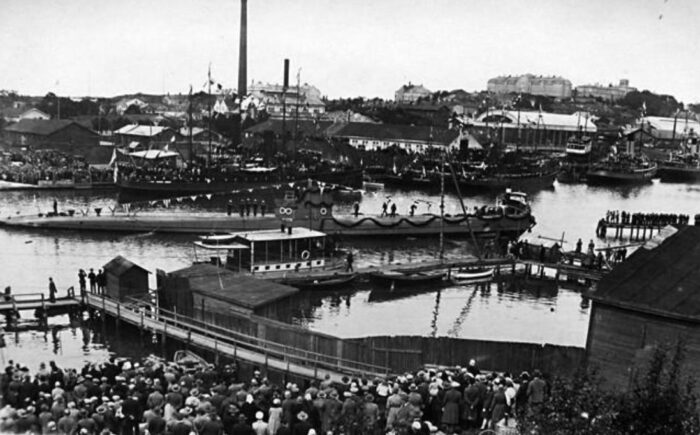
The launch of Vetehinen in 1930
In the late 1920s the Finnish navy expressed the need to upgrade and modernize its assets, counting on a deterrent through armored coastal vessels, submarines and minelayers. Germany at the same time tried to rebuilt its skills in submarine construction and needed a new coastal submarines still prohibited by the Versailles Treaty. The story is well known. To get passed the allied radars, a new company was created in the Hague, Netherlands: NV Ingenieurskantoor voor Sheepsbouw (IvS). The company started working on the basis of the international market’s new interwar needs. A few countries could provide a set of customers, notably Spain, Turkey, and Finland.
A team was sent to Turku, visiting the Chrichton-Vulcan drydock in order to determine if the yard could handle the construction of a submarine, possibly with sub-elements shipped there for final assembly. Next the same team visited Siltarakennus Oy which could act as a local designer. The very first designed turned into a pair of submarines were the “Inonu” subs for Turkey, based on the WWI UC-III design. Next as Germany looked for a coastal model that could fill the need for Finland, first a very small model for Lake Ladoga, and then a more conventional coastal model, which was the prototype for the future German Type II coastal submarine (CV707 design).
Once agreements were signed, the Kriegsmarine sent personal to evaluate the CV707 in secret and assisted to training in Finnish waters by 1933-34. In December 1935, the Parliament approved additional funds to purchase the CV707, which was done on January 1936. Long story short, Finland obtained two coastal submarines and three minelayer submarines. They all took part in the winter and continuation wars… and survived.
However under the Paris Peace Treaty of 1947 between Finland and the Soviet Union, Article 17 stated that
Finland shall refrain from making, fabricating or testing any atomic weapon, self-propelled or guided ammunition, or equipment related to its launch (except for torpedoes and torpedo launchers included in the warships permitted by this Treaty). As well as non-contact explosive sensing mechanisms, sea mines or torpedoes, manned torpedoes, submarines, or other submersible craft, motor torpedo boats, or special types of assault craft.
However towards the later years this was mostly ignored and the Mir submarines was built in Finland in 1987, designed in collaboration between Rauma-Repola and the Institute of Marine Science of the Russian Academy of Sciences. This a civilian deep sea exploration sub capable of driving to 6,000 meters. The CIA was soon concerned this could be used to tap underwater communication cables and the Pentagon pressured Rauma-Repola to cease development. Still Mobimar became after the fall of USSR on,e of the world’s leader in wreck exploration and in the shipping industry, building 16 submarines, notably more recently, tourism submarines for the Titanic site. The last was sold to Korea in 2003. The ban on submarine was officially lifted in September 1990 with the exception of nuclear subs, so now the country is free to develop a new class.
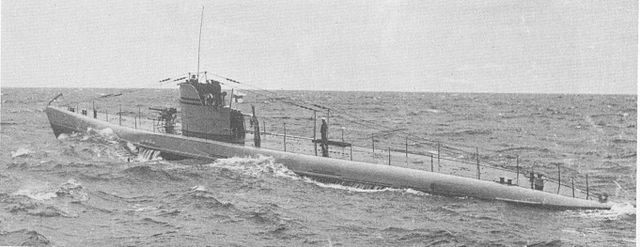
Finland like Sweden and Denmark focuse on mines as a prime form of deterrence, torpedo boats and submarines being second. One premium was to blockade an enemy port in a sneaky way, that is by using a submersible minelayer. Germany in WWI had been cranking up the UC types in mass, and they were reasonably successful, so much so this inspired interwar class in most navies. Though IvS (see below), they were the first Finnish submarines, and arguably the best ones.
As part of the new naval plan, the Finnish naval staff order three submarines, the 500t Vetehinen-class, contacting for this Ingenieurskantoor voor Scheepsbouw den Haag based. They had indeed all the blueprints from the last and best late war minelayer subs, the UC-III and the designers proposed to integrated the best aspects of the close UB-III to get the best of both worlds. As a reminder, the UB-III was the most produced of all WWI submarines in any camp, and the basis for the future mass-produced Type VII, the mainstay U-Boote of the Kriegsmarine. The new sub as ordered was to be built at Finnish Crichton-Vulcan shipyard, in Turku. It was a bit more experienced in ship-building but not on submarine as Mekaniska Verkstad in Helsinki was to built Saukko, resulting in many problems and delays.
Design
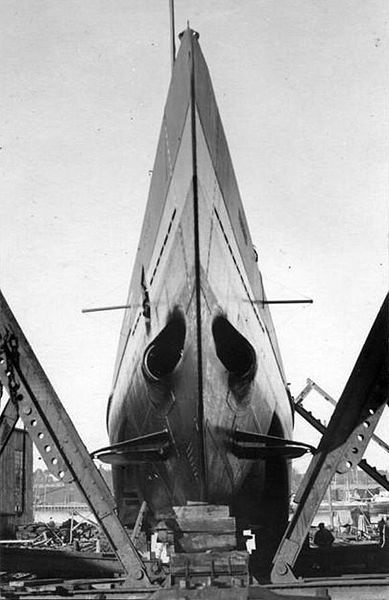 The Vetehinen class was designed as an in-between the Type UB III and Type UC III, with the latter vertical wells/mineshafts containing 20 mines as well as special inner rails for two torpedo tubes with 450 mm (18 in) torpedoes in addition to 533 mm (21 in) torpedoes. The former were intended against merchant vessels. It was given the I.v.S. project number was Pu89 but had many technological improvements developed by the design bureau over the UB-UC III classes.
The Vetehinen class was designed as an in-between the Type UB III and Type UC III, with the latter vertical wells/mineshafts containing 20 mines as well as special inner rails for two torpedo tubes with 450 mm (18 in) torpedoes in addition to 533 mm (21 in) torpedoes. The former were intended against merchant vessels. It was given the I.v.S. project number was Pu89 but had many technological improvements developed by the design bureau over the UB-UC III classes.
The design was also adapted to local Baltic waters conditions.
Hull
The boats had riveted construction. During the design phase, the size increased thrice and diesel power had to be increased from 530 hp to 580 hp. In addition, the pressure hull strength calculations had to be done again and as a result, nine frames had to be strengthened. The Vetehinen were at first intended to be prototypes for rapidly built 500-ton boats. Germany however did not went on with this design for a direct prototype and preferred a larger, 750-ton boat under construction in Spain (project E 1), the Turkish Gür was another direct ancestor to the Type VII.
The outer hull had an overall lenght of 63.5 m, whereas the pressure hull measured 47.1 m long, 3.65 m wide with a thickness of 10 mm and built in frame spaced 600 mm. Her maximum beam was 6.2 m and the keel was made or large plating, 12 mm. The outer hull had frames spaced of 500 mm. The conning tower had 15 mm thick plating as well, and the outer hull had a 3.5-4.0 mm plating. It was however ice-strengthened at the bow and up to amidship, with a reinforced waterline, 750 mm high with an extra 6 mm thick steel layer. Under the pressure hull there was also one meter wide, 60 cm high keel containing the ballast.
The hull comprised 127 frames and 79 for the pressure hull numbered from stern to bow; plus six bulkheaded compartments with largest pressure bulkheads between the aft battery room and the mine shafts, and from there to the Central. They coukd withstand pressure under 75 m and the other compartments watertight bulkheads could withstand pressure under just 4.5 m of water. The maximum diving depth was 75 m overall, with a calculated crush depth of 19 atm or 180 m.
From frame 0 to 17 was located the aft torpedo room and electric motors, from 17 to frame 28 were the Diesel engines, from 28 to 37 were the aft battery, from 37 to 45 the mine shafts, from frame 45 to 53 was the central, from 53 to 62 was the forward battery and from 62 to 79 was the forward torpedo room.
The pressure hull volume was 360 m3. Under outer ballast tank volumes comprised the main ballast tank I (16.440 m3) II (2 x 14.570 m3) and III (2 x 17.580 m3), IV (2 x 18.080 m3), V (2 x 11.850 m3) VI (20.630 m3), the mine shafts tank comprised to 37 m3 tank. The forward torpedo tank comprised two 1.881 m3 and there was a single aft torpedo tank for 1.560 m3. The variable ballast tank was 13 m3 and the variable ballast tank comprised two 7.500 m3 tanks plus a blow tank that was 0.117 m3. There were two forward drinking water tanks of 0.820 m3, and aft drinking water tank of 0.620 m3, a reserve drinking water tank of 0.095 m3, a forward trim tank of 2.379 m3, and aft trim tank of 2.430 m3 and a Distilled water tank of 0.320 m3.
The Vetehinen class had a crew of 3 officers, 5 senior petty officers, 9 petty officers, 13 sailors for 30 in total. Betthing as usual was distributed between the forward and aft torpedo rooms, while the officers were berthed closer to the central in 4-bunk beds cabins, the captain having its own.
The Periscopes were built by Nedinsco in the Netherlands (Neederlansche Instrumenten Compagnie) in Venlo. The company was owned by Zeiss. Two periscopes of 6800 mm length were provided with a magnification from 1.6 to 6 times, diameter 150 mm, top diameter 60 mm for the aerial periscope which had a 90° elevation. The attack periscope was just 31 mm in diameter, with a -10 to +20° elevation.
Powerplant
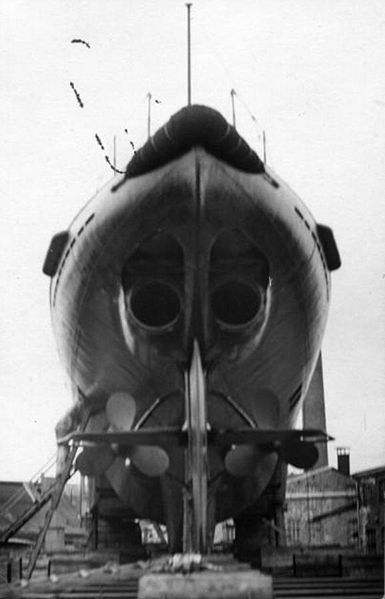 The powerplant comprised two 580 HP Polar-Atlas Diesel (515 rpm) from Sweden. These were Six cylinders, four-stroke models provided with 16 tons of fuel, enough for a Range 1500 miles at 10 knots surfaced. The electric power was provided by two 360 HP Brown-Boveri electric motors (420 rpm) from Switzerland, completed by two 62 cell battery groups for 6350 Ah total. They provided a Range of 75 miles at 4 knots while submerged. These batteries were purchased at Tudor AB in Sweden. The batteries were made under licence of Ackumulatoren-Fabrik AG Hagen located in Berlin.
The powerplant comprised two 580 HP Polar-Atlas Diesel (515 rpm) from Sweden. These were Six cylinders, four-stroke models provided with 16 tons of fuel, enough for a Range 1500 miles at 10 knots surfaced. The electric power was provided by two 360 HP Brown-Boveri electric motors (420 rpm) from Switzerland, completed by two 62 cell battery groups for 6350 Ah total. They provided a Range of 75 miles at 4 knots while submerged. These batteries were purchased at Tudor AB in Sweden. The batteries were made under licence of Ackumulatoren-Fabrik AG Hagen located in Berlin.
Seakeeping properties were to be such that in the Baltic Sea the Vetehinen could operate while surfaced in force 6-8 wind, at 10 knots. Turning radius was less than 200 m. Diving time was less than 30 seconds and surfacing time less than two minutes as specificied in the contract. Speed should was planned to be 13.5 knots surfaced and 8 knots submerged. The diesel capacity, 20 tons was enough for endurance of 150 hours surfaced, just enough for short ranged, coastal minelaying operations or patrols, not offensive patrolling, for example deep into the gulf of Finland up to Leningrad.
Armament
The Vetehinen had an armament of four torpedo tubes with six torpedoes total. The mine wells were horizontal, aft of the CT, with 20 mines tital, mostly for a defensive role.
Torpedo Tubes
The four torpedo tubes (two forward, two aft) were built by Maatschappij voor Scheeps (Fijenoord) in the Netherlands, Rotterdam, owned by Krupp. They were typically for 53 cm torpedoes with possibility of inserting inner guide rails to fire 45 cm torpedoes from Crichton-Vulcan. The tubes were long enough for 6.6 m torpedoes. The 53cm torpedo models were called locally the “T/40” and they were essentially Italian torpedoes, possibly the 1930s W 270/533.4 x 7.2 Veloce. They were powered by a wet-heater, from 3,300 to 4,400 yards (3,000 – 4,000 m) at 50 knots and 13,100 yards (12,000 m) at 30 knots.
Mines
Each boat had two watertight mine shafts, constructed to the norms of German submarine mines. The model was possibly the vintage UC-200. No info available on the type, notably on navweaps.
Deck Guns
The Vetehinen class had a single 76mm/48 Bofors gun forward and a 20 mm Madsen on the rear deck as well as a 12.7 mm machine gun on the CT platform aft.
No data on these rare ordnances.
⚙ Vehehinen class specs. |
|
| Displacement | 493 tonnes surfaced, 716 tonnes submerged |
| Dimensions | 63.5 x 6.2 x 3.6m (208.3 x 20.3 x 11.8 ft) |
| Propulsion | Diesel-electric, 1,016 hp (758 kW) |
| Speed | 12.6 knots (23.3 km/h) surfaced, 8.5 knots (15.7 km/h) submerged |
| Range | 1,575 nmi (2,917 km)/10 knots surfaced, 75 nmi (139 km)/4 knots submerged |
| Armament | 4 × 533 mm TTs, 20 mines, 76 mm/48, 20 mm/60, 12.7 mm |
| Crew | 30 men |
 Vetehinen
Vetehinen

Launch of Vetehinen, on 1st June 1930
Vetehinen was laid down at Ab Crichton-Vulcan Oy, Turku, on 1926–27 (extact date unknown), launched on 1 June 1930 and Commissioned on 13 October the same year. The Finnish Navy received information on the 8,800 ton Soviet icebreaker Yermak underway to the Baltic Sea, from the Atlantic, ideally for an ambush. Vetehinen sortied to intercept her off Liepāja on 4 December. However she ran aground before reaching open sea. Tugs helped free her before she could reattempt her voyage and she arrived at the site on 6 December, then patrolling off the buoy at the entrance. On 7 December Yermak was spotted but she was too slow to reach her. On station she also crossed submarines, suspected to be U-Boats. On 8 December she was underway home when spotting the Soviet Shchuka-class submarine ShCh-324. She tried to sail into position but missed the mark.
On 12 December, Vetehinen sortied again to intercept Yermak from Liepāja to Tallinn but again she ran aground. Divers inspected her and she was pulled free before continuing her mission the same day. However once on site she failed to spot the icebreaker. She was ordered back on 14 December.
On 22 June 1941 with the continuation war, she was sent to lay 0 mines north of Kunda, and 17 mines on 28 June, between Suursaari and Tytärsaari. On 3 July 1941 Vetehinen she spotted a freighter west of Suursaari but could not close fast enough to launch torpedoes, instead she surfaced and gunned it with her 76 mm gun, until she escaped. On 3 August 1941 she spotted a Soviet convoy (minesweepers and guard ships escorting Soviet submarines). She launched a single from 1,500 metres (1,600 yd) but missed. On 8 August 1941 she ambushed a 1500-ton freighter, launched two, apparent hit but they failed to explode.
Until the, Finland used Italian torpedoes named locally T/40. They proved unreliable in service despite positive tests, perhaps due to the massive water temperature difference and caracteristics between the Med and Baltic. It was later discovered that increased water pressure caused the seals of the torpedo detonators to fail. This was later confirmed as the Soviet freighter needed to have the Finnish torpedoes sticking out from her hull to be removed.
On 30 November she was signalled a convoy but failed to reach it.
On 3 December 1941 she was signalled another east from Hanko, she spotted it and engaged these while surfaces but between weak night sights and proactive escort, she missed after firing two bow tubes, made a complete turnaround to fire her stern tubes for no effect, at 2,500 metres (2,700 yd). 15 min. later she spotted another Soviet convoy Westwards but was still reloading torpedoes and was unable to attack.
In 1942 Vetehinen received new 12-hydrophone listening arrays. She also had a depth charge rack with four for her own patrols and her sail was streamlined and rebuilt with a 20 mm installed on its platform, same model as German U-Boats.
On 5 November 1942, she spotted and the Soviet submarine ShCh-305 in the Sea of Åland, and the captain decided to ram her, the difference being sufficient to sink her. It happened during a night patrol. The sub was detected by her hydrophones while Vetehinen was charging her batteries. She launched at first a torpedo, but missed due to the short distance. She also fired deck gun and launched a second torpedo which also missed. She rammed her when ShCh-305 started an emergency dive. This left Vetehinen her bow mushed, but only with a minor leak from the impact. She was repaired back home.
On 5 July 1944 she laid 17 mines near Koivisto islands. Logs stops there. It seems she saw no more service and was discarded in 1946, BU in the 1950s.
 Vesihiisi
Vesihiisi

Vesihiisi was laid down at Crichton like her sister, laid down on 1927, launched on 1 August 1930 and commissioned on 2 December 1931. She was alerted with Vesikko to sail to Hanko on 30 November 1939 when Soviet ships were signalled on their way to this sector. This happened to be the cruiser Kirov and her escorts, but both subs failed to make it in time.
Like her sister she ran aground by early December 1940 but was later freed and repaired. On 27 December she laid 16 mines off Paldiski, a Soviet station, but had no more sortie this winter due to icing. First action of the Continuation War was on 22 June: 20 mines in Estonian waters, 18 more on 24 June at Ruuskeri (SSW Suursaari Island or Gogland and 18 on 26 Jun SE Tytärsaari (Bolshoy Tyuters). Then 18 more on 2 August east of Osmussaar. No kills reported.
On 2 July 1941 she was on patrol east of Suursaari, Gogland when spotting a freighter heading east, launched torpedoes but failed. She escape her escort’s vigorous depth charge attack.
On 5 August 1941 she spotted and attacked a supply convoy for the Hanko Garrison. This was a Iosif Stalin-class liner and two large minesweepers and patrol boats as escorts. But sources diverged. She passed the escort screen, launched two torpedoes from 700 metres (770 yd), they hit but failed to explode. The escorted dephgt charge her, she was forced to dive to 75 metres (246 ft) and returned home for a week’s repairs. In December 1941 she was docked for the winter. This time was used to modify her faulty Italian torpedoes. Like her sister she received new listening arrays, depth charge rack, new conning tower.
On 9 August 1942, she sailed with her sisters to Mariehamn for ASW patrol and escort, in the Sea of Åland. On the 21 October 1942, evening, she spotted, torpedoed and sank the Soviet S-7 near Lågskär. The Soviet Captain Sergei Lisin and three officers escaped the conning tower as she was surfaced when this happened, and they were catpured and interrogated. The rest of the crew went down. On 4 July 1944 Vesihiisi laid 20 mines between Moshchny Island and Seskar but was caught and depht charged by two Soviet minesweepers. She could escape without damage and later laid 18 mines north of Moshchny Island, on 6 July 1944. Her activity stopped there. She was immobilized until 1947 and discarded, BU afterwards.
 Iku-Turso
Iku-Turso
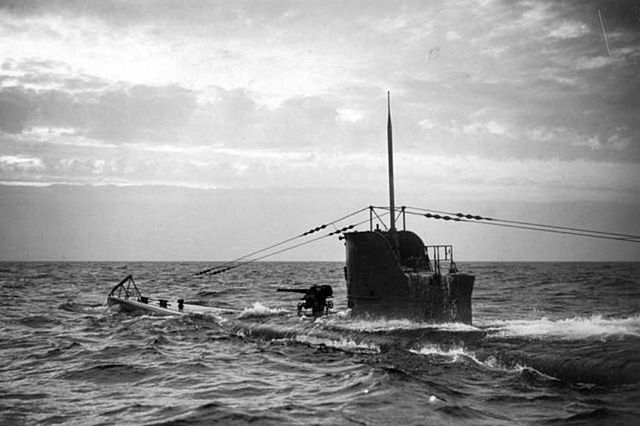
Iku-Turso was laid down like her sisters at Crichton-Vulcan in 1927. She as launched on 5 May 1931, commissioned on 13 October 1931. On 7 December she was signalled to intercept the Soviet freighter Ivan Papanin coming from Stockholm. She sailed to the likely route to Leningrad off Sandhamn and Svenska Högarn by night but her station was interrupting by unidentified patrol boats which forced her to dive. She failed to spot anything later at periscope depth and missed Ivan Papanin which already passed the area hours earlier and followed another course after being warned by the Soviet PBs.
In late December 1941 she patrolled off Liepāja, but was constrained by rules of engagements. By January 1941 she stayed four days off Saaremaa and Hiiumaa, no spot. On 22 June 1941 she laid 20 mines north of the Mohni/Ekholm, 20 mines at Ruuskeri, SE from Gogland (24 June), 18 mines south of Vaindloo (26 June) until operations were postponed until 11 July, off the Estonian coast, east of Mohni.
On 30 July she sortied with Vetehinen to intercept a Soviet convoy to Hanko but they missed to reach attack position. In December 1941 she was in part for the winter and had her unreliable torpedoes modified. She had the same upgrades as her sisters also in 1942.
On 27 October she spotted, fired only damaged a surfaced Soviet Shchuka-class submarine caught by night with her 20 mm Madsen cannon, in poor visibility. She then tried to torpedo another Soviet Shchuka-class but sources are conflicted about its sinking. Iku-Turso observed an oil flick but this was never confirmed by Russian sources, either Shch-320 or Shch-308, claimed by a mine earlier.
On 30 July 1944 she spotted and attacked, but never reached launching position on a tug. On 24 August 1944 she ran into an anti-submarine net but was able to free herself. Still, the next also comprised small magnetic mines and on stayed attached and exploded, breaching only her outer hull. She went back home unscaved. After repairs it seems like her sister she saw no longer any activity from the summer of 1944. She was discarded in 1947 and BU.
Read More/Src

Vesihiisi class minelayers submarines and tender, prewar.
Books
Sopanen, Akseli (August 2019). “Itämeren pieni vaanija Sukellusvene Saukko alkuideoista poistoon saakka 1921–1953” (PDF). University of Eastern Finland.
Kijanen, Kalervo (1968). Suomen Laivasto 1918–1968 I [Finnish Navy 1918–1968, part I]. Helsinki: Meriupseeriyhdistys/Otava.
Kijanen, Kalervo (1968). Suomen Laivasto 1918–1968 II [Finnish Navy 1918–1968, part II]. Helsinki: Meriupseeriyhdistys/Otava.
“Хильде (1894)” (in Russian). Later in 1941 Hilde was sunk at Hanko.
[The Schuka hunt: how Finnish submariners countered Soviet submarines]. Профиль (in Russian).
Polmar, Norman; Noot, Jurrien (1991), Submarines of the Russian and Soviet Navies, 1718–1990: 1718–1990, NIP
Links
on navypedia.org/ fi_ss_vetehinen.htm
on web.archive.org Submarines/subconstr.htm
on globalsecurity.org/
hs.fi/helsinki/
web.archive.org/web/ submarines.htm

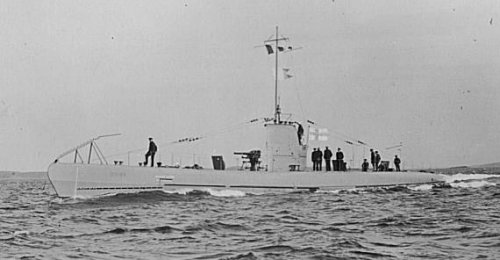

 Latest Facebook Entry -
Latest Facebook Entry -  X(Tweeter) Naval Encyclopedia's deck archive
X(Tweeter) Naval Encyclopedia's deck archive Instagram (@navalencyc)
Instagram (@navalencyc)





 French Navy
French Navy Royal Navy
Royal Navy Russian Navy
Russian Navy Armada Espanola
Armada Espanola Austrian Navy
Austrian Navy K.u.K. Kriegsmarine
K.u.K. Kriegsmarine Dansk Marine
Dansk Marine Nautiko Hellenon
Nautiko Hellenon Koninklije Marine 1870
Koninklije Marine 1870 Marinha do Brasil
Marinha do Brasil Osmanlı Donanması
Osmanlı Donanması Marina Do Peru
Marina Do Peru Marinha do Portugal
Marinha do Portugal Regia Marina 1870
Regia Marina 1870 Nihhon Kaigun 1870
Nihhon Kaigun 1870 Preußische Marine 1870
Preußische Marine 1870 Russkiy Flot 1870
Russkiy Flot 1870 Svenska marinen
Svenska marinen Søværnet
Søværnet Union Navy
Union Navy Confederate Navy
Confederate Navy Armada de Argentina
Armada de Argentina Imperial Chinese Navy
Imperial Chinese Navy Marinha do Portugal
Marinha do Portugal Mexico
Mexico Kaiserliche Marine
Kaiserliche Marine 1898 US Navy
1898 US Navy Sovietskiy Flot
Sovietskiy Flot Royal Canadian Navy
Royal Canadian Navy Royal Australian Navy
Royal Australian Navy RNZN Fleet
RNZN Fleet Chinese Navy 1937
Chinese Navy 1937 Kriegsmarine
Kriegsmarine Chilean Navy
Chilean Navy Danish Navy
Danish Navy Finnish Navy
Finnish Navy Hellenic Navy
Hellenic Navy Polish Navy
Polish Navy Romanian Navy
Romanian Navy Turkish Navy
Turkish Navy Royal Yugoslav Navy
Royal Yugoslav Navy Royal Thai Navy
Royal Thai Navy Minor Navies
Minor Navies Albania
Albania Austria
Austria Belgium
Belgium Columbia
Columbia Costa Rica
Costa Rica Cuba
Cuba Czechoslovakia
Czechoslovakia Dominican Republic
Dominican Republic Haiti
Haiti Hungary
Hungary Honduras
Honduras Estonia
Estonia Iceland
Iceland Eire
Eire Equador
Equador Iran
Iran Iraq
Iraq Latvia
Latvia Liberia
Liberia Lithuania
Lithuania Mandchukuo
Mandchukuo Morocco
Morocco Nicaragua
Nicaragua Persia
Persia San Salvador
San Salvador Sarawak
Sarawak Uruguay
Uruguay Venezuela
Venezuela Zanzibar
Zanzibar Warsaw Pact Navies
Warsaw Pact Navies Bulgaria
Bulgaria Hungary
Hungary

 Bundesmarine
Bundesmarine Dutch Navy
Dutch Navy Hellenic Navy
Hellenic Navy Marina Militare
Marina Militare Yugoslav Navy
Yugoslav Navy Chinese Navy
Chinese Navy Indian Navy
Indian Navy Indonesian Navy
Indonesian Navy JMSDF
JMSDF North Korean Navy
North Korean Navy Pakistani Navy
Pakistani Navy Philippines Navy
Philippines Navy ROKN
ROKN Rep. of Singapore Navy
Rep. of Singapore Navy Taiwanese Navy
Taiwanese Navy IDF Navy
IDF Navy Saudi Navy
Saudi Navy Royal New Zealand Navy
Royal New Zealand Navy Egyptian Navy
Egyptian Navy South African Navy
South African Navy






























 Ukrainian Navy
Ukrainian Navy dbodesign
dbodesign